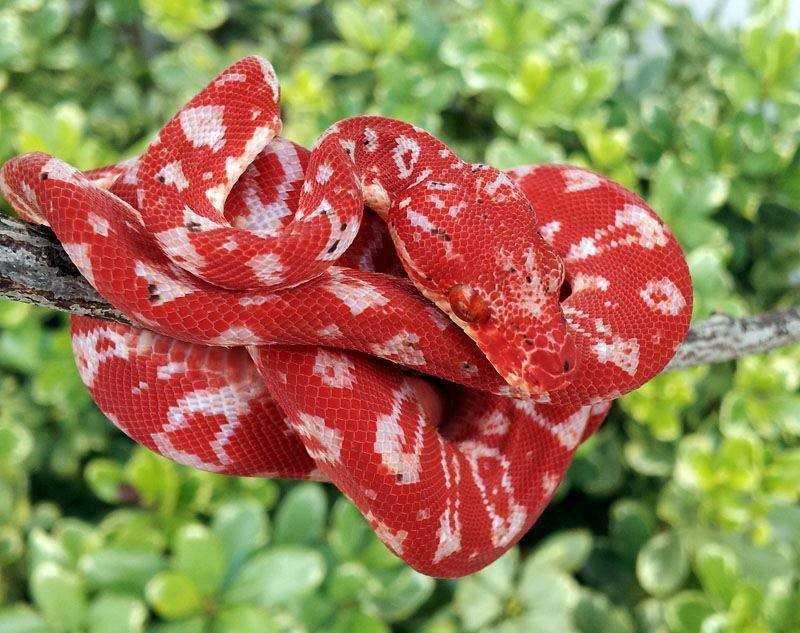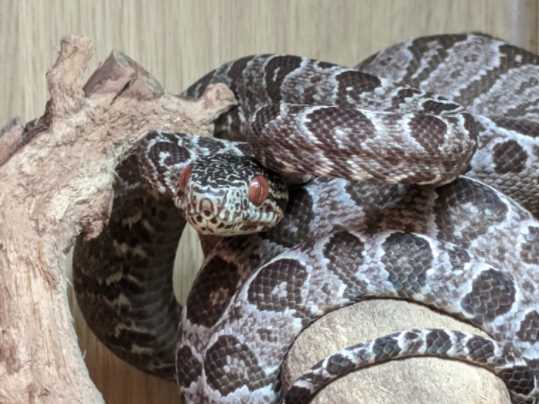
Habitat setup
Creating a suitable habitat for your Amazon tree boa is crucial to their overall health and happiness. These boas are arboreal, which means they spend the majority of their time in trees. As such, a tall enclosure with several branches and perches for climbing is essential. The enclosure should also have ample hiding spots, such as hollow logs or densely planted areas, to provide security for the snake.
Temperature and humidity
Amazon tree boas thrive in warm and humid environments. The enclosure should have a temperature gradient, with a basking spot of around 85-90°F and a cooler side of around 78-82°F. A low-wattage heat lamp or a heat pad can be used to provide the necessary warmth. Additionally, maintaining a humidity level of 60-80% is vital. This can be achieved by misting the enclosure regularly and using a humidity gauge to monitor levels.
All About Amazon Tree Boa Care

Habitat and Environment
Creating the ideal habitat for your Amazon tree boa is crucial. These snakes are arboreal and spend most of their time in trees, so a tall and spacious enclosure is necessary. It should be equipped with plenty of branches and foliage for climbing and hiding.
The temperature and humidity levels in the enclosure should also be carefully maintained. The ambient temperature should be around 80-85 degrees Fahrenheit during the day, with a cooler area provided for the snake to retreat to if needed. At night, the temperature can drop slightly to around 75-80 degrees Fahrenheit.
Feeding and Nutrition
Amazon tree boas primarily feed on small rodents, such as mice and rats. It is essential to provide them with appropriately sized prey items. The food should be slightly larger than the snake’s thickest part to ensure proper digestion and prevent regurgitation.
Health and Maintenance
To keep your Amazon tree boa healthy, regular maintenance is necessary. This includes regular cleaning of the enclosure, removing any feces or uneaten prey items. The water bowl should also be cleaned and refilled regularly to provide clean drinking water for the snake.
Regular health check-ups with a reptile veterinarian are recommended to monitor the snake’s overall health and detect any potential issues early on. Additionally, providing proper UVB lighting and a suitable heat source is important for their overall well-being.
All You Need to Know About Amazon Tree Boa Care: Basic Information

The Amazon Tree Boa is a mesmerizing snake species that is native to the Amazon rainforest. It is known for its vibrant colors and arboreal nature, spending most of its time in trees. If you are considering getting an Amazon Tree Boa as a pet, here is some basic information you need to know:
- Size: Adult Amazon Tree Boas can grow to be around 4-6 feet in length.
- Lifespan: With proper care, these snakes can live up to 20 years in captivity.
- Temperament: Amazon Tree Boas are generally docile and can become quite tame with regular handling. However, they may become defensive if they feel threatened.
- Temperature and Humidity: Maintaining the correct temperature and humidity levels is essential for the health of your Amazon Tree Boa. The temperature should range from 80-85°F during the day and drop slightly at night. The humidity should be kept around 60-70%.
Overall, caring for an Amazon Tree Boa requires attention to detail and a suitable enclosure that mimics their natural habitat. With proper care and handling, these beautiful snakes can make fascinating pets for experienced reptile enthusiasts.
Habitat and Environment

These boas can be found in a variety of habitats within the Amazon rainforest, including tropical rainforests, flooded forests, and savannahs. They prefer to live near bodies of water, such as rivers or streams, as this provides them with a source of hydration and also attracts their prey.
The Amazon tree boa is a nocturnal species, meaning they are most active at night. During the day, they retreat to the dense foliage of the trees, where they hide and rest. Their green coloration helps them blend in with the leaves, providing them with excellent camouflage.
- Temperature and Humidity: The Amazon tree boa requires a temperature range of 75-85°F during the day and a slight drop to 70-75°F at night. They also need a humidity level of 50-70%, which can be achieved by misting their enclosure regularly.
- Enclosure: A large and vertically oriented enclosure is essential for the Amazon tree boa. It should be outfitted with sturdy branches and perches for climbing, as well as hiding spots for security. The enclosure should also have proper ventilation to maintain the required humidity levels.
- Diet: These boas are carnivores and feed on a variety of prey, including rodents, birds, and small mammals. In captivity, they can be fed a diet of appropriately sized frozen/thawed rodents that have been previously fed a nutritious diet.
- Health and Hygiene: Regular health check-ups with a reptile veterinarian are important to ensure the boa’s overall well-being. It is also crucial to maintain a clean enclosure by regularly removing waste and providing fresh water.
Providing the appropriate habitat and environment for your Amazon tree boa is crucial to their health and well-being. By replicating their natural habitat as closely as possible, you can ensure that your boa is happy and thriving in captivity.
Feeding and Nutrition
Feeding and nutrition play a vital role in the care of Amazon tree boas. These snakes are carnivores, which means they rely on a diet of small mammals, birds, and reptiles. In captivity, you can feed them pre-killed prey items such as mice, rats, and chicks.
Proper feeding technique is also important to ensure the health and well-being of your Amazon tree boa. You should never feed your boa live prey, as this can lead to injury or stress for both the snake and the prey. Instead, use tongs or forceps to offer the pre-killed prey, allowing the boa to strike and constrict it.
In summary, feeding and nutrition are key aspects of Amazon tree boa care. Providing a varied diet, appropriate prey size, and using proper feeding techniques will help ensure the health and well-being of your boa.
Health and Maintenance

Proper health and maintenance are essential for keeping your Amazon tree boas happy and thriving. Here are some important factors to consider:
1. Veterinary Care: It’s crucial to have a reptile-friendly veterinarian who can provide regular check-ups and address any health concerns. Routine visits can help prevent potential health issues and ensure the overall well-being of your Amazon tree boa.
2. Temperature and Humidity: Maintaining the right temperature and humidity levels in their enclosure is vital. Amazon tree boas require a temperature range of 80-85°F (27-29°C) during the day and a drop to around 75°F (24°C) at night. The humidity should be kept between 60-80% to simulate their natural habitat.
3. Enclosure Cleanliness: Regular cleaning of the enclosure is essential for maintaining a healthy environment. Remove any uneaten food, shed skins, and waste promptly. Disinfect the enclosure regularly to prevent the growth of bacteria or fungi.
4. Proper Feeding: Feed your Amazon tree boa a diet of appropriately sized rodents, such as mice or rats. Juvenile boas should be fed every 5-7 days, while adults can be fed every 10-14 days. Ensure the prey is of high quality and nutritionally balanced.
5. Handling: While Amazon tree boas can tolerate occasional handling, they are generally more reclusive and prefer minimal disturbance. If you do handle your boa, make sure to do so gently and avoid excessive stress or rough handling.
6. Regular Observations: Keep a close eye on your Amazon tree boa for any signs of illness or behavioral changes. Look out for symptoms like loss of appetite, lethargy, respiratory issues, or abnormal shedding. Early detection of problems can make a significant difference in the boa’s overall health and well-being.
By following these guidelines, you can ensure that your Amazon tree boa remains healthy and happy for years to come.

I’m Lena Adams—a product of an unconventional upbringing in the African wilderness. My father, a daring explorer of African wildlife, sparked my fascination with reptiles, a passion that intertwined with the tragic loss of my mother during an expedition, leaving an indelible mark on my life. Driven to understand the creatures that captivated my parents, I embarked on my journey, sharing insights about reptiles, frogs, and lizards on my website. Through my explorations and conservation efforts, I honour my family’s legacy while seeking connections—to the creatures, nature, and the mother whose presence I yearn to understand.
